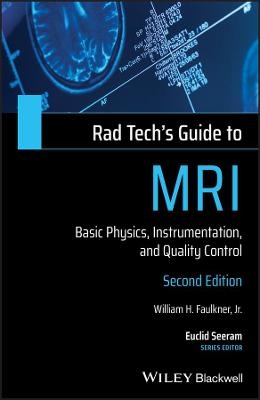
Rad Tech's Guide to MRI
Wiley-Blackwell (Verlag)
978-1-119-50857-1 (ISBN)
Written by an expert practitioner and educator, this handy reference guide:
Provides essential MRI knowledge in a single portable, easy-to-read guide
Covers instrumentation and MRI hardware components, including gradient and radio-frequency subsystems
Provides techniques to handle flow imaging issues and improve the quality of MRIs
Explains the essential physics underpinning MRI technology
Rad Tech's Guide to MRI is a must-have resource for student radiographers, especially those preparing for the American Registry of Radiation Technologist (ARRT) exams, as well as practicing radiology technologists looking for a quick reference guide.
William H. Faulkner, Jr. is a radiologic technologist and MRI education and operations consultant with William Faulkner and Associates. He is a founding board member of the American Board of Magnetic Resonance Safety (ABMRS) and author and co-author of several books on magnetic resonance imaging and computed tomography including the Handbook of MRI Technique and Review Questions for MRI.
1. Hardware Overview 1
Instrumentation: Magnets 1
Instrumentation: RF Subsystem 6
Instrumentation: Gradient Subsystem 8
2. Fundamental Principles 11
Electromagnetism: Faraday’s Law of Induction 11
Magnetism 12
Behavior of Hydrogen in a Magnetic Field 14
3. Production of Magnetic Resonance Signal 19
4. Relaxation and Tissue Characteristics 23
T2-Relaxation 23
T1-Relaxation 24
Proton Density 24
T2* (Pronounced “T2 star”) 25
5. Data Acquisition and Image Formation 27
Pulse Sequences 27
Image Contrast Control 30
Image Formation 42
Data Acquisition 43
Scan Time 50
Controlling Image Quality with FSE 57
6. Magnetic Resonance Image Quality 61
Spatial Resolution 61
Signal-to-Noise Ratio (SNR) 63
7. Artifacts 75
Chemical Shift (Water and Fat in Different Voxels) 75
Chemical Shift (Water and Fat in the Same Voxel) 77
Magnetic Susceptibility 79
Motion and Flow 81
Spatial Presaturation 82
Gradient Moment Nulling (Flow Compensation) 84
Compensation for Respiration 84
Cardiac Compensation 86
Aperiodic Motion 88
Aliasing 89
Gibbs and Truncation Artifact 91
Radio-Frequency Artifacts 92
Gradient Malfunctions 93
Image Shading 93
Inadequate System Tuning 94
Reconstruction Artifacts 94
8. Flow Imaging 97
Flow Patterns 97
Magnetic Resonance Angiography (Non Contrast) 98
Reduction of Flow Artifacts 102
Signal Loss in MRA 102
Two-Dimensional and Three-Dimensional Time-of-Flight 103
Signal Loss with Two-Dimensional TOF 104
Three-Dimensional TOF 106
Signal Loss with Three-Dimensional TOF 108
PC Techniques 109
Contrast Enhanced MRA (CE-MRA) 113
9. Diffusion and Perfusion Imaging 117
Diffusion-Weighted Imaging (DWI) 117
10. Gadolinium-Based Contrast Agents 125
Characteristics, Composition and Structure 125
Index 129
| Erscheinungsdatum | 29.02.2020 |
|---|---|
| Reihe/Serie | Rad Tech's Guides' |
| Mitarbeit |
Herausgeber (Serie): Euclid Seeram |
| Verlagsort | Hoboken |
| Sprache | englisch |
| Maße | 140 x 213 mm |
| Gewicht | 204 g |
| Themenwelt | Medizin / Pharmazie ► Allgemeines / Lexika |
| Medizinische Fachgebiete ► Radiologie / Bildgebende Verfahren ► Nuklearmedizin | |
| Medizinische Fachgebiete ► Radiologie / Bildgebende Verfahren ► Radiologie | |
| Naturwissenschaften ► Chemie | |
| Technik | |
| ISBN-10 | 1-119-50857-6 / 1119508576 |
| ISBN-13 | 978-1-119-50857-1 / 9781119508571 |
| Zustand | Neuware |
| Informationen gemäß Produktsicherheitsverordnung (GPSR) | |
| Haben Sie eine Frage zum Produkt? |
aus dem Bereich


